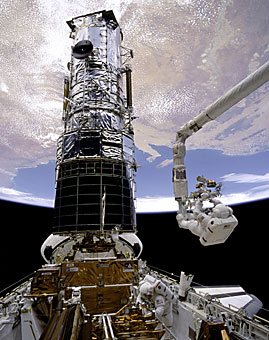 |
|
PHOTO COURTESY OF NASA
|
Astronauts F. Story Musgrave and Jeffrey Hoffman conclude five days of space walks to repair the Hubble Space Telescope in 1993. UA scientists and researchers are hopeful that NASA will carry out the repairs needed to keep the telescope functional into the future.
|
|
|
By J. Ferguson
Arizona Daily Wildcat
Wednesday, May 4, 2005
Print this
With Moore's law stating that computer performance will double every 18 months, what do you call a 15-year-old telescope floating in space?
One UA astronomer said he calls it the greatest scientific instrument in NASA's arsenal.
The Hubble Space Telescope, which turned 15 years old last week, is still a valuable asset for astronomers, said Rodger Thompson, UA astronomy professor and the principal investigator on the Near Infrared Camera and Multi-Object Spectrometer instrument on HST.
Thompson said the telescope, launched in 1990, was only intended to last 10 years. Thompson said the life span of the telescope was prolonged "once we saw how good it was."
While the HST is currently functioning with only two of its three gyroscopes and with a major component no longer working, some might question why some astronomers want to see a fourth servicing missing.
Chris Impey, a professor of astronomy and deputy director of the Steward Observatory, said the answer is simple: education.
"One of Hubble's greatest assets is as a learning tool," Impey said.
Impey said NASA's policy on allowing all the data from HST to be available to the public one year after it was taken is one of the best ways to educate students.
"This allows an 11th-grade kid to drag down an image," Impey said. "Occasionally, a high school student makes a discovery with the data."
NASA also uses HST data to make educational packets for classrooms.
Impey said he has used the educational packets from NASA, as well as raw HST data to teach his NATS 102 class.
Impey said in addition to classroom education, UA astronomers are leading between 15 and 18 projects using HST every year.
"Students get to use real data (from HST) for research," Impey said.
Until a major systems failure in HST makes observations impossible, Impey said he believes UA astronomers will continue to vie for HST projects.
Impey said the number of HST projects would increase if there were a fourth servicing mission. The mission would replace the gyroscopes, add new batteries and add two new instruments - a third-generation Wide Field Camera and a high-resolution spectrograph - but has been postponed following the 2003 Columbia shuttle disaster.
"There would be six or eight (more projects) added to the gene pool (of available astronomers)," Impey said.
Not all scientific observations depend on future projects.
The infrared NICMOS sensor, which allows astronomers to observe the night sky using infrared light, was installed on Hubble in 1997.The funding for the NICMOS team has since run out, but at least one member of the NICMOS team is still sifting through data from HST.
Marcia Rieke, a UA astronomy professor and a former investigator for the NICMOS team, said she is still working with data she received a year and a half ago.
"It takes a while to go through all that data," Rieke said.
